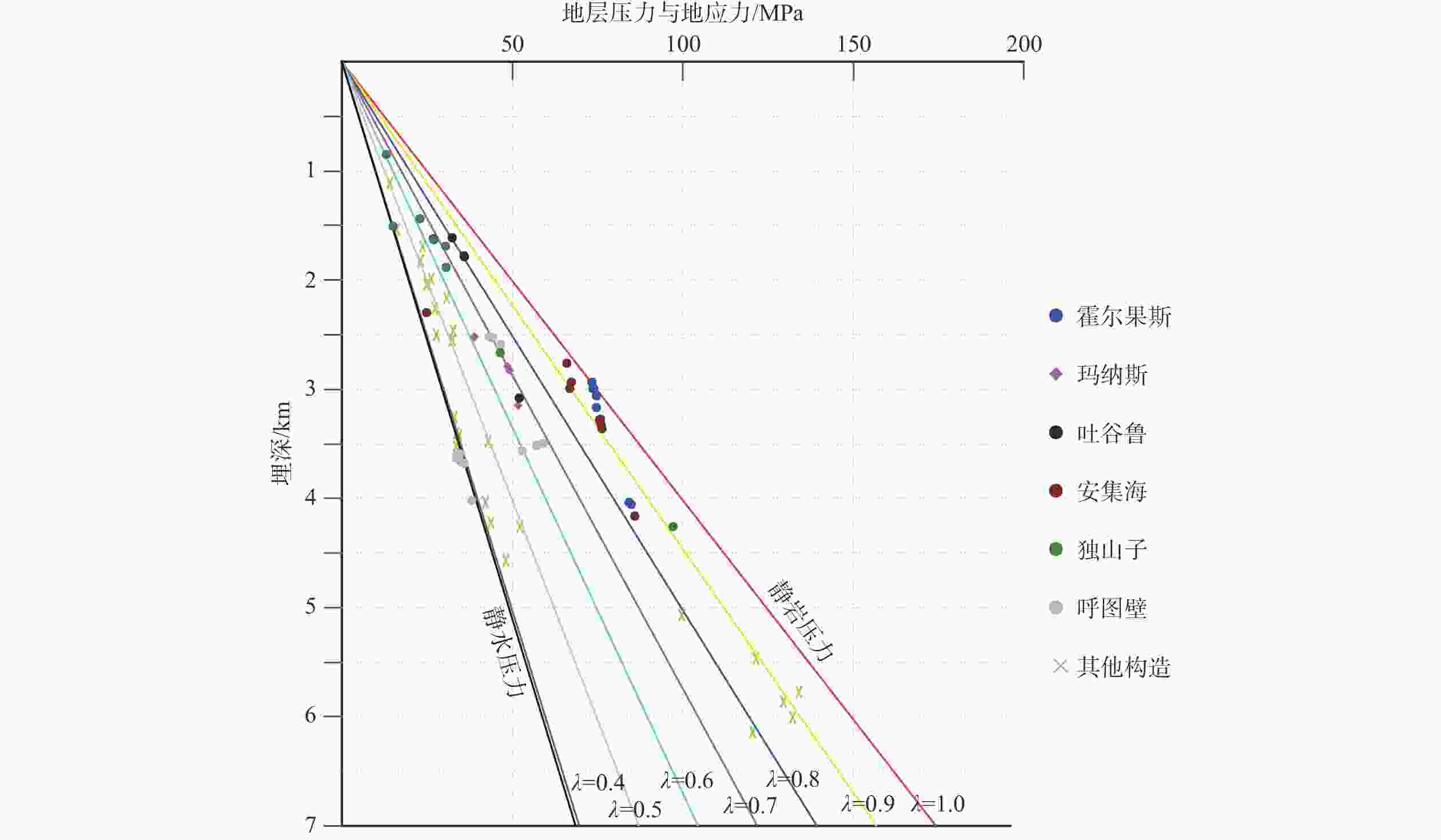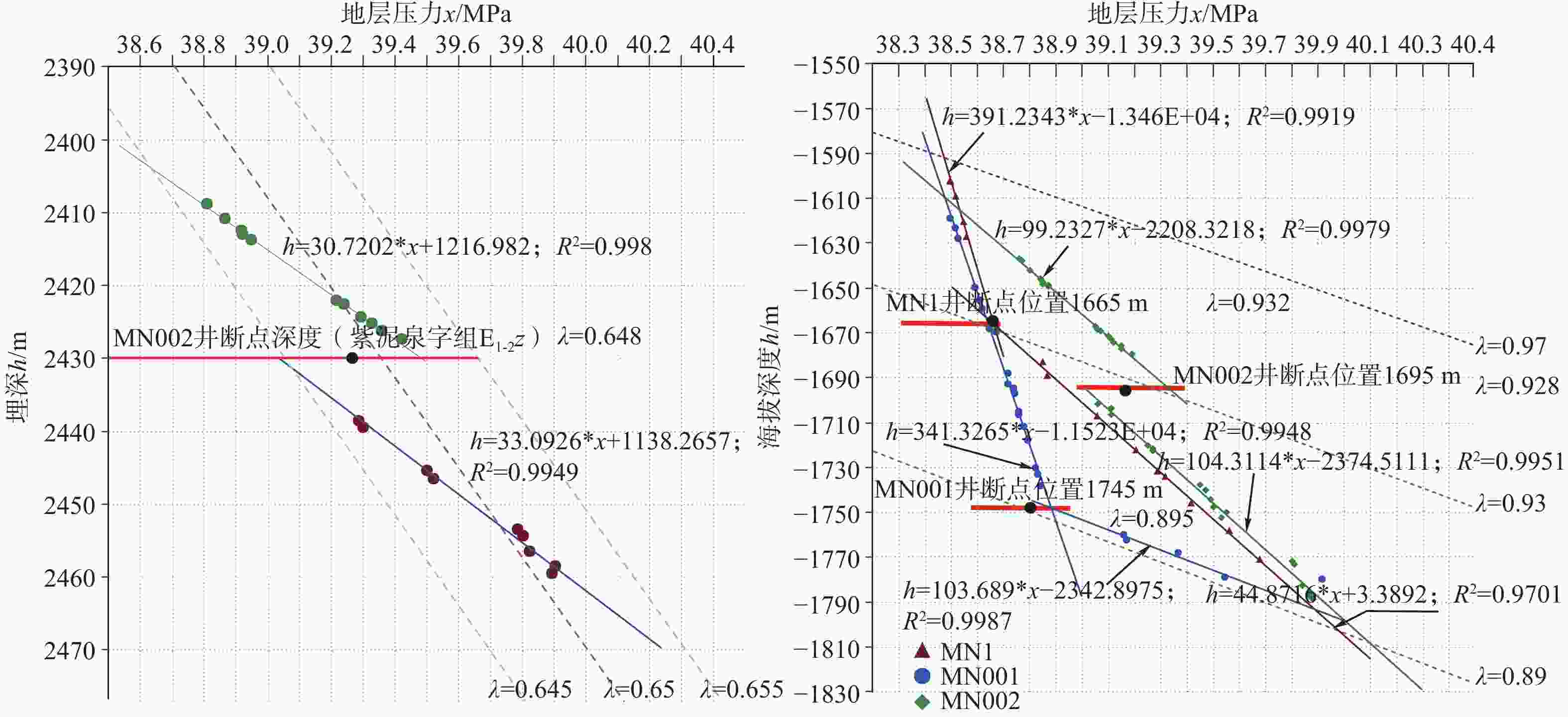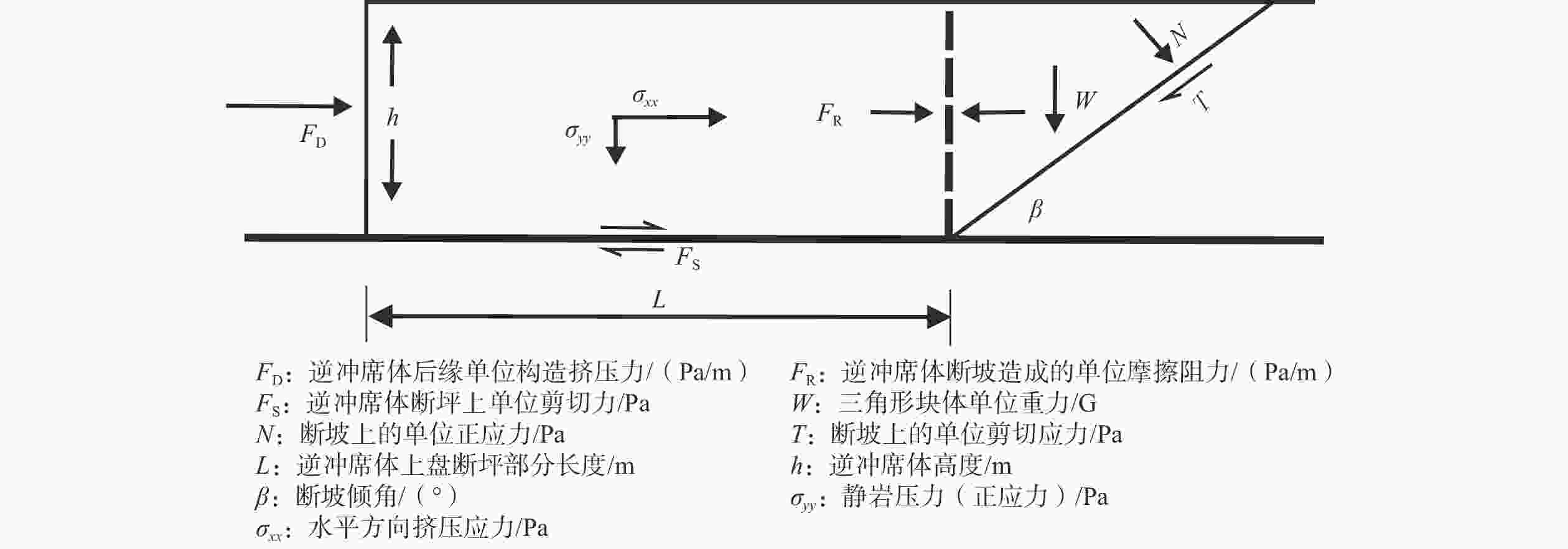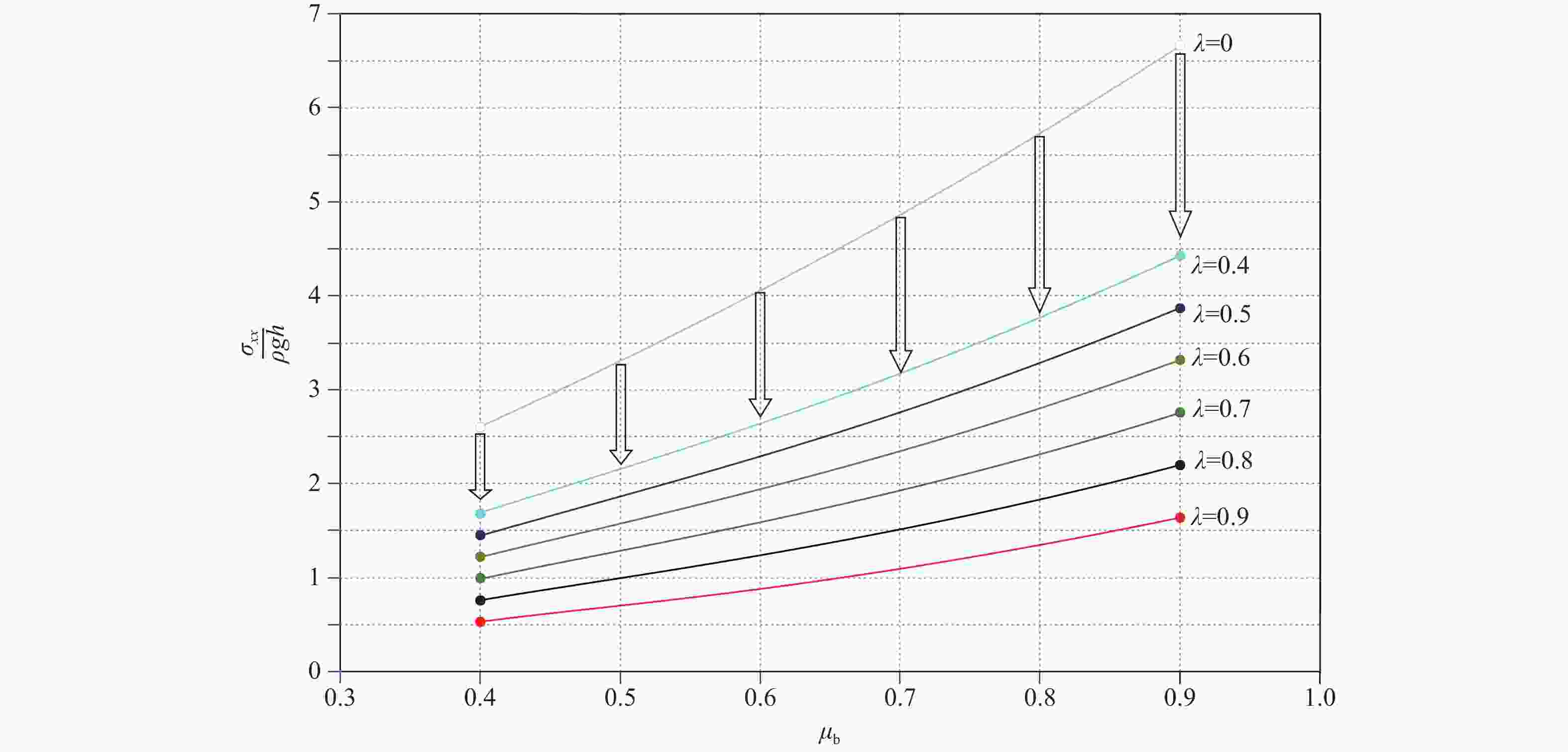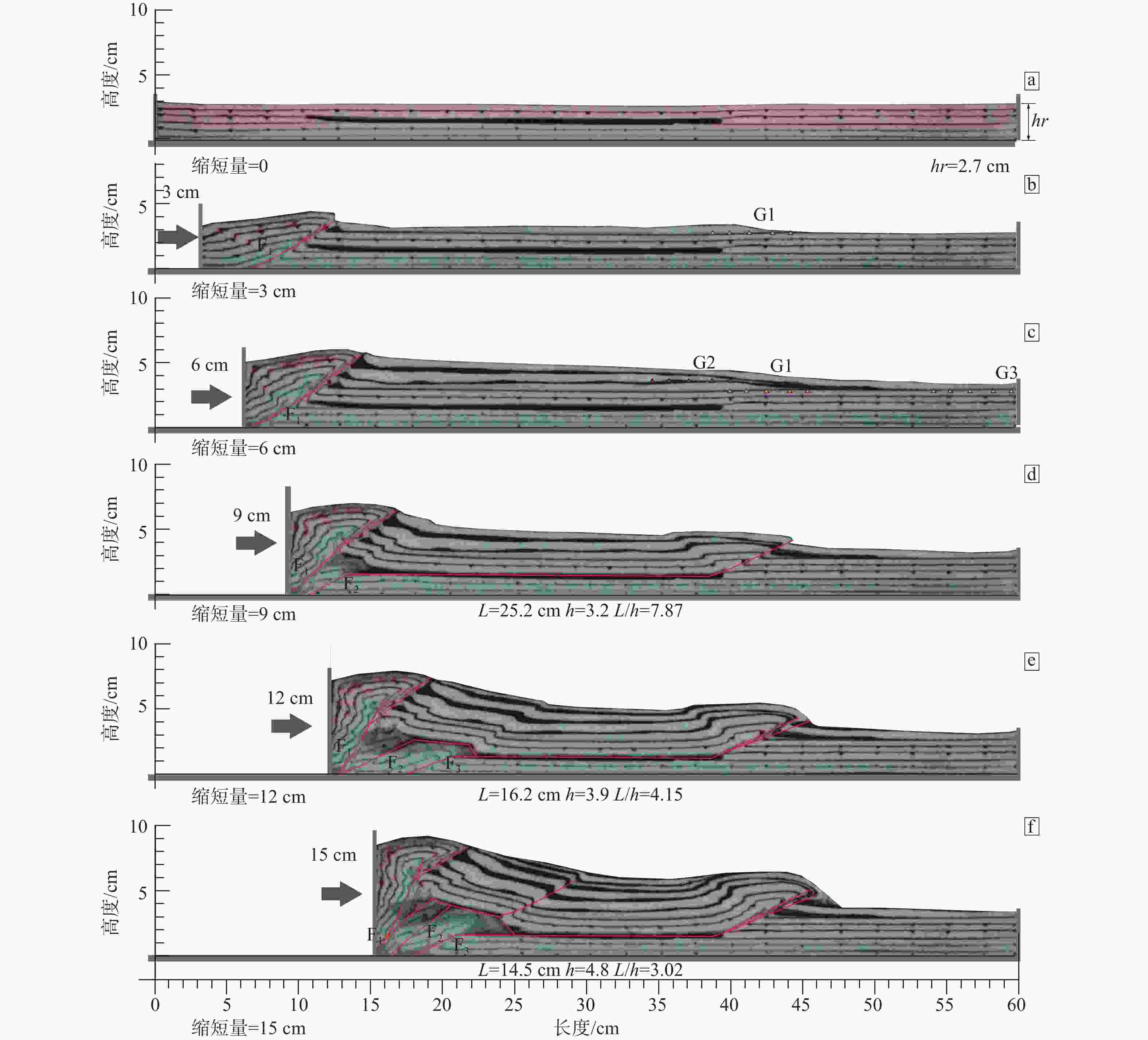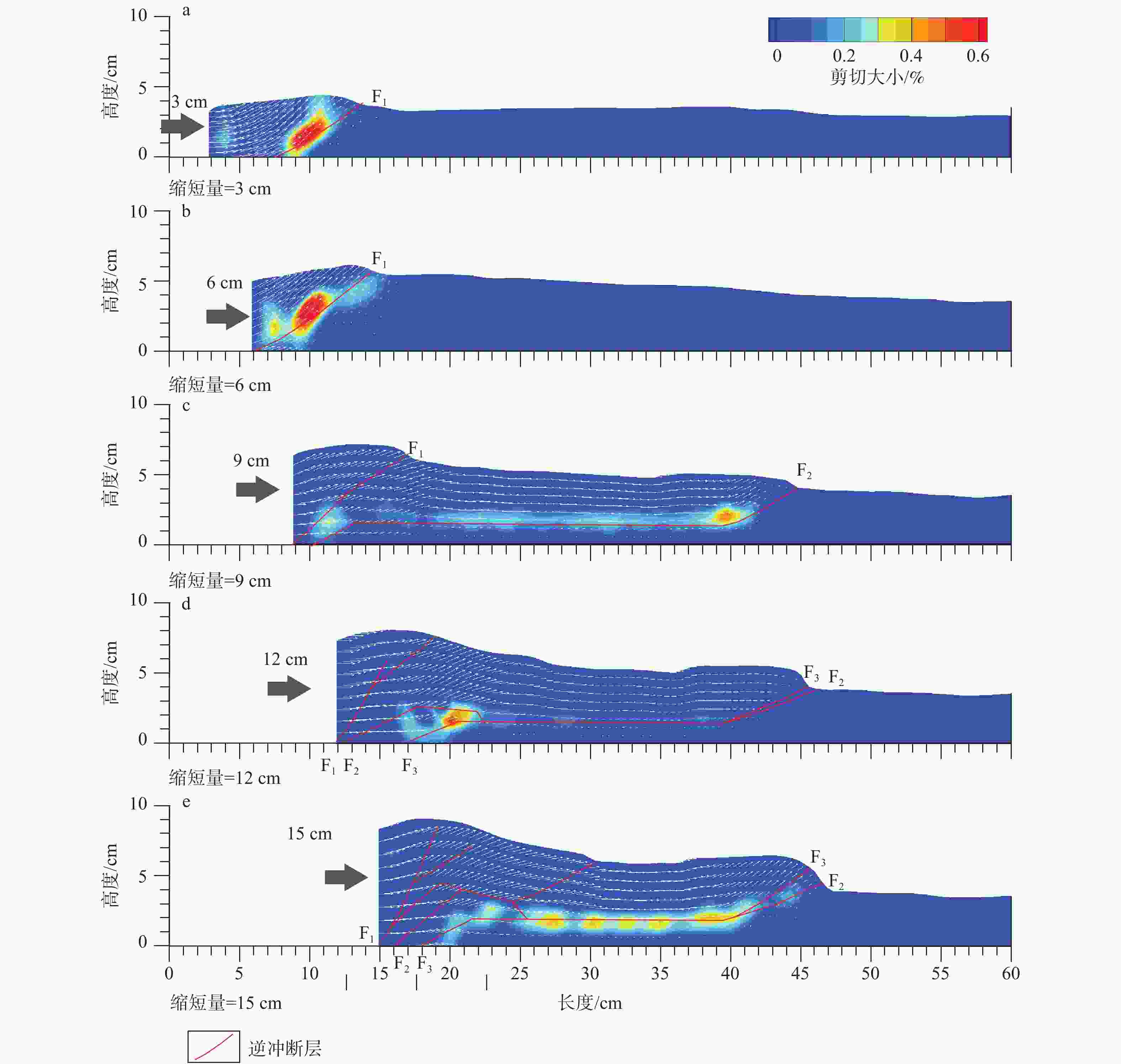Mechanics and analog modeling of the Huo-Ma-Tu thrust sheet in the southern Junggar Basin fold and thrust belt
-
摘要: 逆冲岩席发育的力学机制厘定是认识冲断带变形过程的基础与难点。文章以准南冲断带为研究实例,结合力学模型与物理模拟对逆冲岩席发育的力学机制进行探讨。依据地质调查、地震资料解释和钻井资料证实霍−玛−吐背斜核部和南翼发育有逆冲断层,断层向南延伸到第一排背斜之下,并形成广泛分布的霍−玛−吐逆冲席体,席体内部基本上无构造变形。霍−玛−吐构造带的钻井资料显示准南逆冲带前缘逆冲断层及滑脱断层均发育在流体压力系数较高的异常超压层中,说明该逆冲岩席属于强干变形席体、弱滑脱断层组合。根据玛纳斯构造带的钻井实测地层压力计算出逆冲断层的上下盘压力系数明显不同,且逆冲断层上盘的流体压力系数在逆冲断层处急剧降低,说明上盘逆冲岩席底部为弱滑脱层,有效分隔了上、下盘流体压力系统。文章依据地震剖面和钻井资料标定获得的霍−玛−吐逆冲岩席变形几何学特征,建立了后缘挤压下逆冲席体变形的简化力学模型,并计算出逆冲席体后缘水平挤压应力与垂直方向的重力比值与逆冲席体几何参数及断层摩擦系数和断坡角之间的数学关系式,分别给出了无流体超压的逆冲席体和含有流体超压滑脱层逆冲席体的数学关系式。为了验证力学模型可靠性,对准南逆冲带中的霍−玛−吐逆冲席体发育特征进行了物理模拟实验研究。结果证实该类型的刚性逆冲席体变形规律前缘逆冲断层发育样式符合地震剖面的构造解释认识,也佐证了简化的力学模型符合实际地质情况。实验结果表明逆冲席体底部大位移是多地段同时发生的小范围位移累积而成大位移,为认识造山带内推覆体或造山带前缘逆冲席体大规模远距离推覆问题提供了理论依据。Abstract:
Objective Understanding the mechanical development of thrust sheets is fundamental, yet challenging, to comprehensively understand the deformation processes of thrust belts. Various models explain the mechanics behind thrust sheet development, yet significant controversies persist. Methods This study takes a comprehensive approach, focusing on the southern Junggar Thrust Belt. We combine a variety of methods including surface geological surveys, seismic reflection profiles, and drilling data analysis with mechanical and physical modeling to thoroughly investigate this issue. Results (1) Based on surface geological surveys, seismic data interpretation, and drilling data, we confirm that thrust faults have developed in the core and southern limb of the Huo-Ma-Tu anticline. These faults extend southward beneath the front of anticlines, forming the extensively distributed Huo-Ma-Tu thrust sheet, which exhibits none to weak internal structural deformation. (2) Drilling data from the Huo-Ma-Tu structural belt clearly show that the frontal thrust faults and detachment faults have developed in layers with abnormally high fluid pressure, indicating that the thrust sheet is a combination of strong deformation sheets and weak detachment faults. Analysis of in-situ formation pressure data suggests that the thrust faults within these overpressure layers can segregate fluid pressure coefficients between the hanging wall and the footwall. (3) Using the geometric deformation characteristics of the Huo-Ma-Tu thrust sheet obtained from seismic profiles and drilling data, a simplified mechanical model is established. This model calculates the mathematical relationship between the horizontal compressive stress-to-gravity ratio at the back of the thrust sheet, the geometric parameters of the thrust sheet, the fault friction coefficient, and the fault dip angle. Separate equations are provided for thrust sheets without fluid overpressure and those with fluid overpressure detachment layers. (4) A physical model of the development characteristics of the Huo-Ma-Tu thrust sheet in the Southern Junggar Thrust Belt confirms that the deformation pattern of such rigid thrust sheets aligns with the structural interpretation from seismic profiles. This supports the validity of the simplified mechanical model in reflecting the actual geological conditions. Conclusions The simplified mechanical model demonstrates that the required horizontal tectonic stress-to-gravity ratio at the back of the thrust sheet decreases significantly with increasing fluid pressure coefficient. The physical modeling results also verify that the deformation pattern of strong deformation sheets/weak detachment fault thrust sheets generally conform to the structural interpretations of the seismic profiles. The experiments reveal that the large displacements at the base of the thrust sheet result from the accumulation of small-scale displacements coinciding across multiple segments. Significance This study proposes simplified rectangular with triangular geometric models of thrust sheets, which can preliminarily explain the kinematics and dynamics of thrust sheets, especially those with fluid overpressure. The derived mathematical relationships accurately describe the geometric, kinematic, and dynamic relationships of thrust sheets and are robustly validated by physical simulation experiments, reinforcing the reliability of our findings. -
图 1 准噶尔盆地南缘逆冲褶皱带地质简图
a—准南逆冲褶皱带地质简图;b—齐古背斜−吐北背斜构造解释剖面
Figure 1. Geological map of the southern Junggar Basin thrust and fold belt
(a) Simplified geological map of the southern Junggar fold and thrust belt; (b) Structural interpretation of the seismic profile across the Qigu-Tugulu anticline based on surface geology and well data
图 2 准南逆冲褶皱带实测地层压力与深度及流体压力系数关系图。准南逆冲带钻井实测压力数据(压力数据来自新疆油田分公司,2007)
Figure 2. Graph showing the relationships between the fluid pressure and the Hubbert-Rubey pore-fluid pressure ratio (λ) as functions of depth. Fluid pressure data of wells from the southern Junggar fold and thrust belt, derived from in situ formation test. ( The data are from Xinjiang Oilfield Company, 2007)
图 3 玛纳斯背斜钻井地层压力与深度及孔隙流体压力系数关系图
a— MN002井MDT实测紫泥泉子组地层压力图; b— MDT实测安集海河组地层压力图(压力数据来自新疆油田分公司,2007)
Figure 3. Graphs showing the relationships between fluid pressure and Hubbert-Rubey pore-fluid pressure ratio (λ) as functions of depth through wells in the Manasi anticline.
(a) Pressures measured by the MDT technology in the MN002 well for the Ziniquanzi Formation (E1-2z); (b) Pressures measured by the MDT technology in the MN1, MN001, and MN002 wells for the Anjihaihe Formation (E1-2a)(Formation pressure data from Xinjiang Oilfield Company, 2007)
表 1 不同断层摩擦系数(μb)和不同流体压力系数下计算的水平挤压应力与重力比值
Table 1. The tectonic stress to gravitational stress ratio varies with different sliding friction coefficients and Hubbert-Rubey pore-fluid pressure ratio (λ)
水平压力与
重力比值摩擦系数 0.40 0.50 0.60 0.70 0.80 0.90 流体压力系数 0.0 2.60 3.31 4.06 4.86 5.72 6.66 0.4 1.68 2.15 2.65 3.19 3.77 4.43 0.5 1.45 1.86 2.30 2.77 3.29 3.87 0.6 1.22 1.57 1.94 2.35 2.80 3.31 0.7 0.99 1.28 1.59 1.93 2.32 2.76 0.8 0.76 0.99 1.24 1.51 1.83 2.20 0.9 0.53 0.70 0.88 1.10 1.34 1.64 -
[1] ANDERSON E M, 1951. The dynamics of faulting and dyke formation with applications to Britain[M]. 2nd ed. Edinburgh: Oliver and Boyd: 206. [2] BONINI M, SOKOUTIS D, MULUGETA G, et al., 2000. Modelling hanging wall accommodation above rigid thrust ramps[J]. Journal of Structural Geology, 22(8): 1165-1179. doi: 10.1016/S0191-8141(00)00033-X [3] BOYER S E, ELLIOTT D, 1982. Thrust systems[J]. AAPG Bulletin, 66(9): 1196-1230. [4] BURCHFIEL B C, BROWN E T, DENG Q D, et al., 1999. Crustal shortening on the margins of the Tien Shan, Xinjiang, China[J]. International Geology Review, 41(8): 665-700, doi: 10.1080/00206819909465164 [5] BUTLER R W H, 1982. The terminology of structures in thrust belts[J]. Journal of Structural Geology, 4(3): 239-245. doi: 10.1016/0191-8141(82)90011-6 [6] BYERLEE J, 1993. Model for episodic flow of high-pressure water in fault zones before earthquakes[J]. Geology, 21(4): 303-306. doi: 10.1130/0091-7613(1993)021<0303:MFEFOH>2.3.CO;2 [7] CELLO G, NUR A, 1988. Emplacement of foreland thrust systems[J]. Tectonics, 7(2): 261-271. doi: 10.1029/TC007i002p00261 [8] CHAPPLE W M, 1978. Mechanics of thin-skinned fold-and-thrust belts[J]. GSA Bulletin, 89(8): 1189-1198. [9] CHEN Z X, LEI Y L, JIA D, et al. , 2019. Physical analog and structural modeling techniques and applications[M]. Beijing: Science Publish Press: 249. (in Chinese) [10] COOPER M A, 1981. The internal geometry of nappes: criteria for models of emplacement[M]//MCCLAY K R, PRICE N J. Thrust and nappe tectonics. London: Geological Society, Special Publications, 9(1): 225-234. [11] CRUSET D, CANTARERO I, BENEDICTO A, et al., 2022. From hydroplastic to brittle deformation: controls on fluid flow in fold and thrust belts. Insights from the Lower Pedraforca thrust sheet (SE Pyrenees)[J]. Marine and Petroleum Geology, 120: 104517, doi: 10.1016/j.marpetgeo.2020.104517 [12] DAHLEN F A, SUPPE J, DAVIS D, 1984. Mechanics of fold-and-thrust belts and accretionary wedges: cohesive coulomb theory[J]. Journal of Geophysical Research: Solid Earth, 89(B12): 10087-10101. doi: 10.1029/JB089iB12p10087 [13] DAHLEN F A, SUPPE J, 1988. Mechanics, growth, and erosion of mountain belts[M]//CLARK S P JR, BURCHFIEL B C, SUPPE J. Processes in continental lithospheric deformation. Boulder: Geological Society of America: 161-178. [14] DAHLEN F A, 1990. Critical taper model of fold-and-thrust belts and accretionary wedges[J]. Annual Review of Earth and Planetary Sciences, 18(1): 55-99, doi: 10.1146/annurev.ea.18.050190.000415 [15] DAHLSTROM C D A, 1970. Structural geology in the eastern margin of the Canadian rocky mountains[J]. Bulletin of Canadian Petroleum Geology, 18(3): 332-406. [16] DAVIS D M, SUPPE J, DAHLEN F A, 1983. Mechanics of fold-and-thrust belts and accretionary wedges[J]. Journal of Geophysical Research: Solid Earth, 88(B2): 1153-1172. doi: 10.1029/JB088iB02p01153 [17] DAVIS D M, ENGELDER T, 1985. The role of salt in fold-and-thrust belts[J]. Tectonophysics, 119(1-4): 67-88. doi: 10.1016/0040-1951(85)90033-2 [18] ELLIOTT D, 1976a. The motion of thrust sheets[J]. Journal of Geophysical Research, 81(5): 949-963. doi: 10.1029/JB081i005p00949 [19] ELLIOTT D, 1976b. The energy balance and deformation mechanisms of thrust sheets[J]. Philosophical Transactions of the Royal Society A: Mathematical, Physical & Engineering Sciences, 283(1312): 289-312. [20] GRAULS D J, BALEIX J M, 1994. Role of overpressures and in situ stresses in fault-controlled hydrocarbon migration: a case study[J]. Marine and Petroleum Geology, 11(6): 734-742, doi: 10.1016/0264-8172(94)90026-4 [21] GRETENER P E, 1972. Thoughts on overthrust faulting in a layered sequence[J]. Bulletin of Canadian Petroleum Geology, 20(3): 583-607. [22] GRETENER P E, 1981. Pore pressure, discontinuities, isostasy and overthrust[M]//MCCLAY K R, PRICE N J. Thrust and nappe tectonics. London: Geological Society, Special Publications, 9(1): 33-39. [23] HAFNER W, 1951. Stress distributions and faulting[J]. GSA Bulletin, 62(4): 373-398. [24] HATCHER R D JR, 2004. Properties of thrusts and upper bounds for the size of thrust sheets[M]//MCCLAY K R. Thrust tectonics and hydrocarbon systems. Tulsa: American Association of Petroleum Geologists, 82: 18-29. [25] HUBBERT M K, RUBEY W W, 1959. Role of fluid pressure in mechanics of overthrust faulting: I. Mechanics of fluid-filled porous solids and its application to overthrust faulting[J]. Geological Society of America Bulletin, 70(2): 115-166. doi: 10.1130/0016-7606(1959)70[115:ROFPIM]2.0.CO;2 [26] JINGHWA HSŰ K, 1969. Role of cohesive strength in the mechanics of overthrust faulting and of landsliding[J]. GSA Bulletin, 80(6): 927-952. doi: 10.1130/0016-7606(1969)80[927:ROCSIT]2.0.CO;2 [27] KELHE R O, 1970. Analysis of gravity sliding and orogenic translation[J]. GSA Bulletin, 81(6): 1641-1664. doi: 10.1130/0016-7606(1970)81[1641:AOGSAO]2.0.CO;2 [28] KELLY P G, Peacock D C P, SANDERSON D J, et al., 1999. Selective reverse-reactivation of normal faults, and deformation around reverse-reactivated faults in the Mesozoic of the Somerset coast[J]. Journal of Structural Geology, 21(5): 493-509. doi: 10.1016/S0191-8141(99)00041-3 [29] KNIPE R J, 1995. Footwall geometry and the rheology of thrust sheets[J]. Journal of Structural Geology, 7(1): 1-10. [30] KOYI H A, MAILLOT B, 2007. Tectonic thickening of hanging-wall units over a ramp[J]. Journal of Structural Geology, 29(6): 924-932. doi: 10.1016/j.jsg.2007.02.014 [31] LI M H, LI Z, LIAO J D, 2005. Analysis of ground stress in the southern part of Jungger Basin and discussions of the related issues[J]. Xinjiang Geology, 23(4): 343-346. (in Chinese with English abstract [32] LIU J Y, RANALLI G, 1992. Stresses in an overthrust sheet and propagation of thrusting: an airy stress function solution[J]. Tectonics, 11(3): 549-559. doi: 10.1029/92TC00104 [33] LU X S, ZHUO Q G, ZHAO M J, et al. , 2020. The quantitative evaluation techniques for source-reservoir configuration and fault-caprock combinations in foreland basins (confidentiality of technical Report)[R]. (in Chinese) [34] LU X S, ZHAO M J, ZHANG F Q, et al., 2022. Characteristics, origin and controlling effects on hydrocarbon accumulation of overpressure in foreland thrust belt of southern margin of Junggar Basin, NW China[J]. Petroleum Exploration and Development, 49(5): 859-870. (in Chinese with English abstract [35] LUO X R, WANG Z M, ZHANG L Q, et al., 2007. Overpressure generation and evolution in a compressional tectonic setting, the southern margin of Junggar Basin, northwestern China[J]. AAPG Bulletin, 91(8): 1123-1139, doi: 10.1306/02260706035 [36] MANDL G, SHIPPAM G K, 1981. Mechanical model of thrust sheet gliding and Imbrication[M]//MCCLAY K R, PRICE N J. Thrust and nappe tectonics. London: Geological Society, Special Publications, 9(1): 79-98, doi: 10.1144/GSL.SP.1981.009.01.08. [37] MANDL G, 1988. Mechanics of tectonic faulting: models and basic concepts[M]. Amsterdam: Elsevier: 407. [38] MERLE O, ABIDI N, 1995. Approche experimentale du fonctionnement des rampes emergentes[J]. Bulletin de la Société Géologique de France, 166(5): 439-450. [39] MERLE O, 1998. Emplacement mechanisms of nappes and thrust sheets[M]. Dordrecht, Boston: Kluwer Academic Publishers: 159. [40] MITRA S, 1986. Duplex structures and imbricate thrust systems: geometry, structural position, and hydrocarbon potential[J]. AAPG Bulletin, 70(9): 1087-1112. [41] MULUGETA G, SOKOUTIS D, 2003. Hanging wall accommodation styles in ramp-flat thrust models[M]//NIEUWLAND D A. New insights into structural interpretation and modelling. London: Geological Society, Special Publications, 212(1): 197-207. [42] PRICE N J, COSGROVE J W, 1990. Analysis of geological structures[M]. Cambridge: Cambridge University Press: 502. [43] PRICE R A, 1988. The mechanical paradox of large overthrusts[J]. GSA Bulletin, 100(12): 1898-1908. [44] QIU J H, RAO G, WANG X, et al., 2019. Effects of fault slip distribution on the geometry and kinematics of the southern Junggar fold-and-thrust belt, northern Tian Shan[J]. Tectonophysics, 772: 228209, doi: 10.1016/j.tecto.2019.228209 [45] RICH J L, 1934. Mechanics of low-angle overthrust faulting as illustrated by Cumberland thrust block, Virginia, Kentucky, and Tennessee[J]. AAPG Bulletin, 18(12): 1584-1596. [46] SERRA S, 1977. Styles of deformation in the ramp regions of overthrust faults[C]// WGA, 2005 - Rocky Mountain Thrust Belt Geology and Resources; 29th Annual Field Conference Guidebook, 1977 Proceedings of the twenty-ninth annual field conference Wyoming geological association guidebook: 487-498. [47] SMITH A G, 1981. Subduction and coeval thrust belts, with particular reference to North America[M]//MCCLAY K R, PRICE N J. Thrust and nappe tectonics. London: Geological Society, Special Publications, 9(1): 111-124. [48] SMOLUCHOWSKI M S, 1909. II. Some remarks on the mechanics of overthrusts[J]. Geological Magazine, 6(5): 204-205. doi: 10.1017/S0016756800120941 [49] SUPPE J, HUANG M H, CARENA S, 2009. Mechanics of thrust belts and the weak-fault/strong-crust problem[J]. Trabajos de Geología, 29: 61-65. [50] TURNER J P, WILLIAMS G A, 2004. Sedimentary basin inversion and intra-plate shortening[J]. Earth-Science Reviews, 65(3-4): 277-304. doi: 10.1016/j.earscirev.2003.10.002 [51] WASHINGTON P A, PRICE R A, 1990. The mechanical paradox of large overthrusts: alternative interpretation and reply[J]. GSA Bulletin, 102(4): 529-532. doi: 10.1130/0016-7606(1990)102<0529:TMPOLO>2.3.CO;2 [52] WILLIAMS G, CHAPMAN T, 1983. Strains developed in the hangingwalls of thrusts due to their slip/propagation rate: a dislocation model[J]. Journal of Structural Geology, 5(6): 563-571. doi: 10.1016/0191-8141(83)90068-8 [53] WILTSCHKO D V, 1979. A mechanical model for thrust sheet deformation at a ramp[J]. Journal of Geophysical Research: Solid Earth, 84(B3): 1091-1104. doi: 10.1029/JB084iB03p01091 [54] WILTSCHKO D V, 1981. Thrust sheet deformation at a ramp: summary and extensions of an earlier model[M]//MCCLAY K R, PRICE N J. Thrust and nappe tectonics. London: Geological Society, Special Publications, 9(1): 55-63. [55] XINJIANG OILSUBCOMPANY, 2007. Geological reports of well MN1 and Well MN001 completion(confidentiality of technical informations)[R]. (in Chinese) [56] XU X W, DENG Q D, ZHANG P Z, et al. , 1996. Deformation of fluvial terraces across the Manas-Huoerguos reverse fault and fold zone and its neotectonic implication in Xinjiang, northwestern China[C]//Editing Committee of the Research of Active Fault. Research of active fault (II). Beijing: Seismology Press: 117-127. (in Chinese with English abstract [57] YANG G, LI W, LI B L, et al., 2012a. Activity thrust faults and overpressure in the thrust and fold belt of southern Junggar Basin[J]. Chinese Journal of Geology, 47(3): 669-684. (in Chinese with English abstract [58] YANG G, LI W, BAI Z H, et al., 2012b. Calibration of thrust faults with abnormal formation pressure data tested during drilling: an example from the southern fold-thrust belt in Junggar Basin[J]. Oil& Gas Geology, 33(2): 200-207. (in Chinese with English abstract [59] YANG G, ZHAO M J, CHEN Z X, et al., 2016. Geometric evidence for several synchronous thrust faulting activities of the thrust belt in the southern margin of Junngar, North Tianshan[J]. Acta Geologica Sinica, 90(4): 639-652. (in Chinese with English abstract [60] YIN A, 1989. Origin of regional, rooted low-angle normal faults: a mechanical model and its tectonic implications[J]. Tectonics, 8(3): 469-482. doi: 10.1029/TC008i003p00469 [61] ZUCCARI C, VIOLA G, CURZI M, et al., 2022. What steers the “folding to faulting” transition in carbonate-dominated seismic fold-and-thrust belts? New insights from the eastern southern Alps (northern Italy)[J]. Journal of Structural Geology, 157: 104560, doi: 10.1016/j.jsg.2022.104560 [62] 陈竹新,雷永良,贾东,等,2019. 构造变形物理模拟与构造建模技术及应用[M]. 北京:科学出版社:249. [63] 李民河,李震,廖健德,2005. 准噶尔盆地南缘地应力分析及相关问题探讨[J]. 新疆地质,23(4):343-346. doi: 10.3969/j.issn.1000-8845.2005.04.005 [64] 鲁雪松,卓勤功,赵孟军等,2020. 前陆盆地源储配置与断-盖组合定量评价技术[R] [65] 鲁雪松,赵孟军,张凤奇,等,2022. 准噶尔盆地南缘前陆冲断带超压发育特征、成因及其控藏作用[J]. 石油勘探与开发,49(5):859-870. doi: 10.11698/PED.20220103 [66] 新疆油田分公司,2007. MN1井和MN001井完井地质报告[R] [67] 杨庚,李伟,李本亮,等,2012a. 准南逆冲褶皱带超压与逆冲断层持续活动[J]. 地质科学,47(3):669-684. [68] 杨庚,李伟,白振华,等,2012b. 用钻井地层异常压力参数标定逆断层的方法:以准噶尔盆地南部逆冲褶皱带为例[J]. 石油与天然气地质,33(2):200-207. [69] 杨庚,赵孟军,陈竹新,等,2016. 准噶尔南缘逆冲带多个逆冲断层同期活动的几何学证据[J]. 地质学报,90(4):639-652. doi: 10.3969/j.issn.0001-5717.2016.04.004 -





 下载:
下载:
